MPM7001: Project Management Report, Welsh Government Analysis
VerifiedAdded on 2023/04/23
|23
|5760
|159
Report
AI Summary
This report provides a comprehensive analysis of project management practices within the context of the Welsh Government. It begins with an introduction outlining the importance of effective project management, followed by an examination of key knowledge areas, including scope, time, cost, communication, risk, and quality management. For each area, the report defines relevant processes and strategies, evaluates past, current, and potential future scenarios, and recommends strategies for achieving project management excellence. The report emphasizes the need for timely reviews, conflict resolution, and adherence to governmental guidelines. It covers topics such as project schedule management, cost control, communication plans, risk identification, and quality assurance, offering a practical guide for improving project outcomes within the Welsh Government framework. The report also explores the crucial role of communication, risk, and quality management in delivering successful projects and meeting client expectations, providing a detailed overview of processes to be followed by project managers and team members.
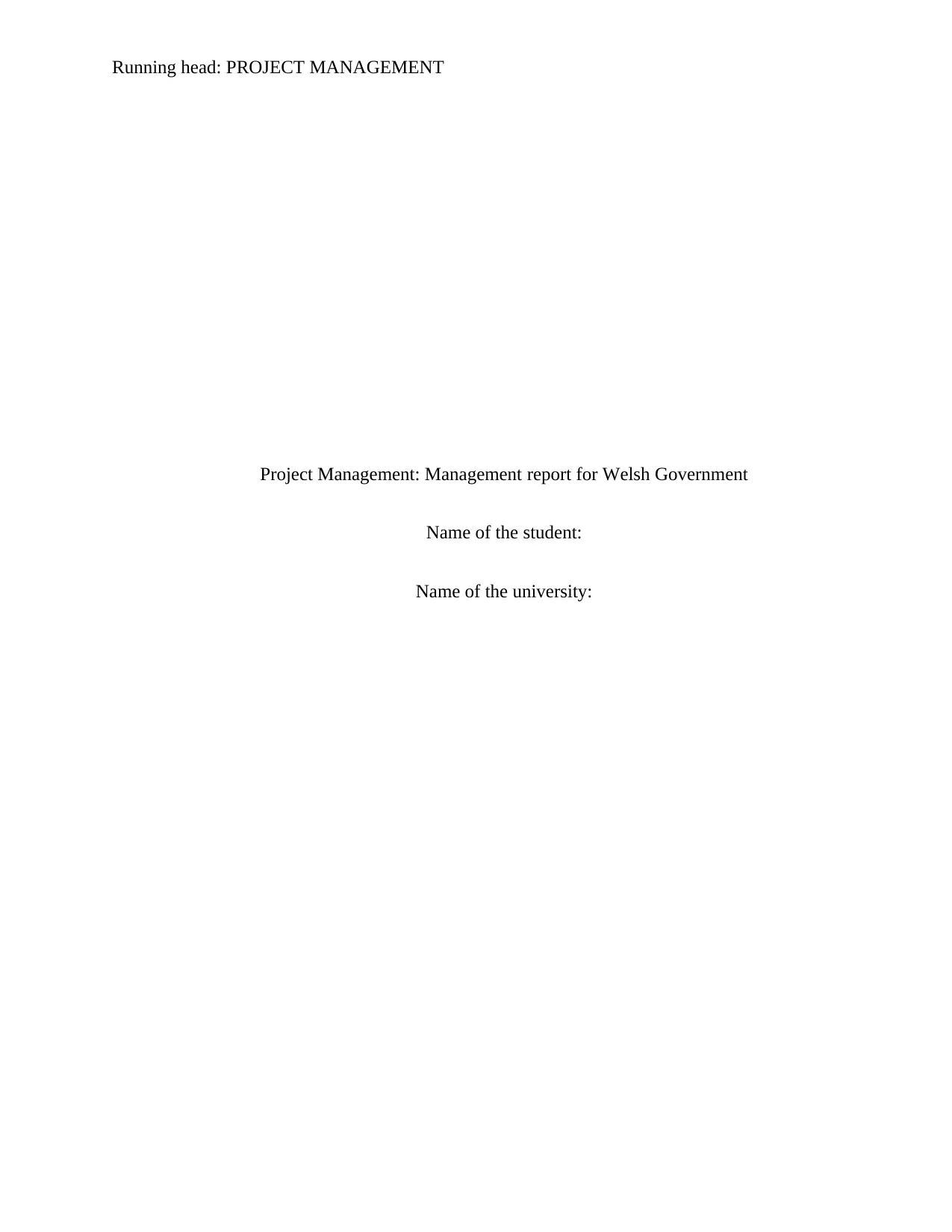
Running head: PROJECT MANAGEMENT
Project Management: Management report for Welsh Government
Name of the student:
Name of the university:
Project Management: Management report for Welsh Government
Name of the student:
Name of the university:
Paraphrase This Document
Need a fresh take? Get an instant paraphrase of this document with our AI Paraphraser
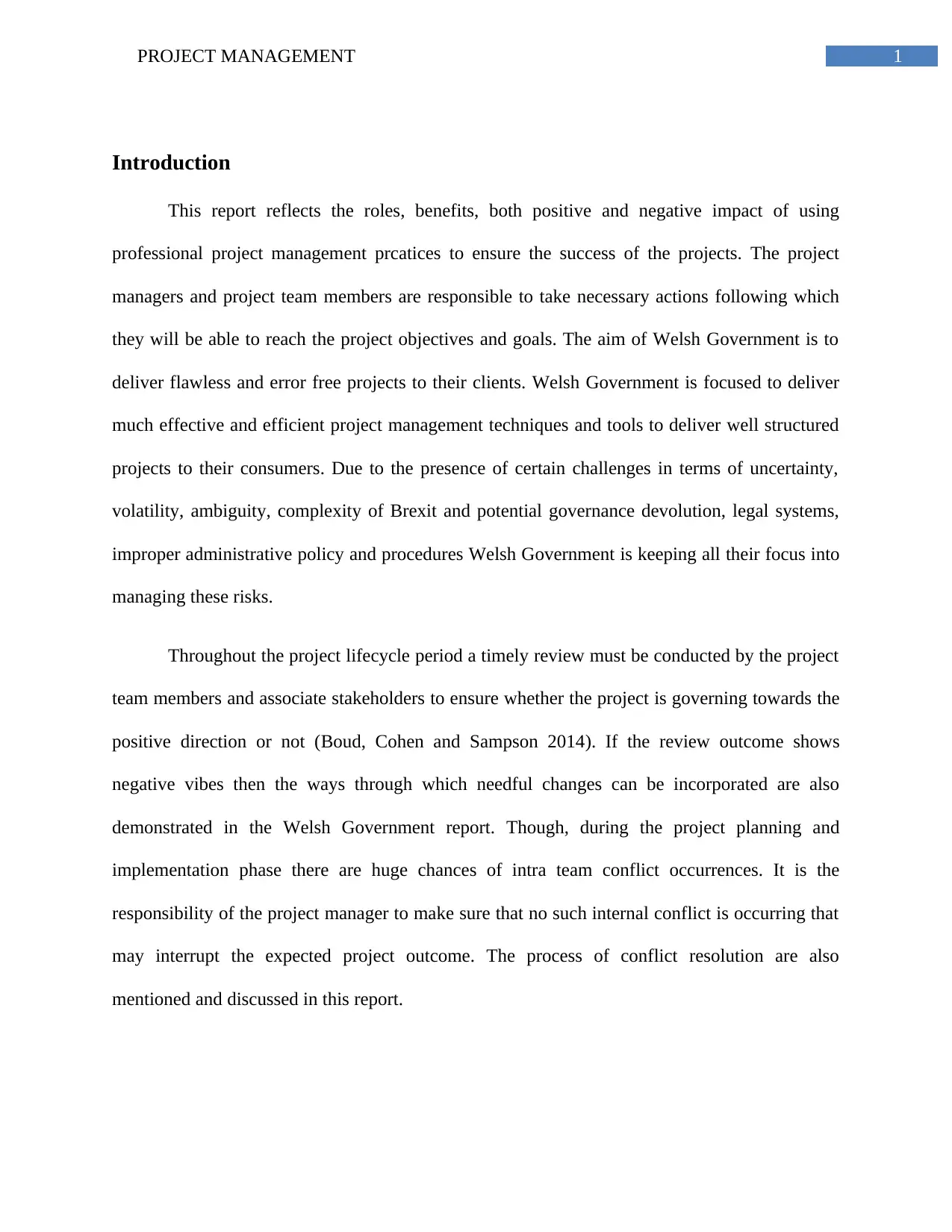
1PROJECT MANAGEMENT
Introduction
This report reflects the roles, benefits, both positive and negative impact of using
professional project management prcatices to ensure the success of the projects. The project
managers and project team members are responsible to take necessary actions following which
they will be able to reach the project objectives and goals. The aim of Welsh Government is to
deliver flawless and error free projects to their clients. Welsh Government is focused to deliver
much effective and efficient project management techniques and tools to deliver well structured
projects to their consumers. Due to the presence of certain challenges in terms of uncertainty,
volatility, ambiguity, complexity of Brexit and potential governance devolution, legal systems,
improper administrative policy and procedures Welsh Government is keeping all their focus into
managing these risks.
Throughout the project lifecycle period a timely review must be conducted by the project
team members and associate stakeholders to ensure whether the project is governing towards the
positive direction or not (Boud, Cohen and Sampson 2014). If the review outcome shows
negative vibes then the ways through which needful changes can be incorporated are also
demonstrated in the Welsh Government report. Though, during the project planning and
implementation phase there are huge chances of intra team conflict occurrences. It is the
responsibility of the project manager to make sure that no such internal conflict is occurring that
may interrupt the expected project outcome. The process of conflict resolution are also
mentioned and discussed in this report.
Introduction
This report reflects the roles, benefits, both positive and negative impact of using
professional project management prcatices to ensure the success of the projects. The project
managers and project team members are responsible to take necessary actions following which
they will be able to reach the project objectives and goals. The aim of Welsh Government is to
deliver flawless and error free projects to their clients. Welsh Government is focused to deliver
much effective and efficient project management techniques and tools to deliver well structured
projects to their consumers. Due to the presence of certain challenges in terms of uncertainty,
volatility, ambiguity, complexity of Brexit and potential governance devolution, legal systems,
improper administrative policy and procedures Welsh Government is keeping all their focus into
managing these risks.
Throughout the project lifecycle period a timely review must be conducted by the project
team members and associate stakeholders to ensure whether the project is governing towards the
positive direction or not (Boud, Cohen and Sampson 2014). If the review outcome shows
negative vibes then the ways through which needful changes can be incorporated are also
demonstrated in the Welsh Government report. Though, during the project planning and
implementation phase there are huge chances of intra team conflict occurrences. It is the
responsibility of the project manager to make sure that no such internal conflict is occurring that
may interrupt the expected project outcome. The process of conflict resolution are also
mentioned and discussed in this report.
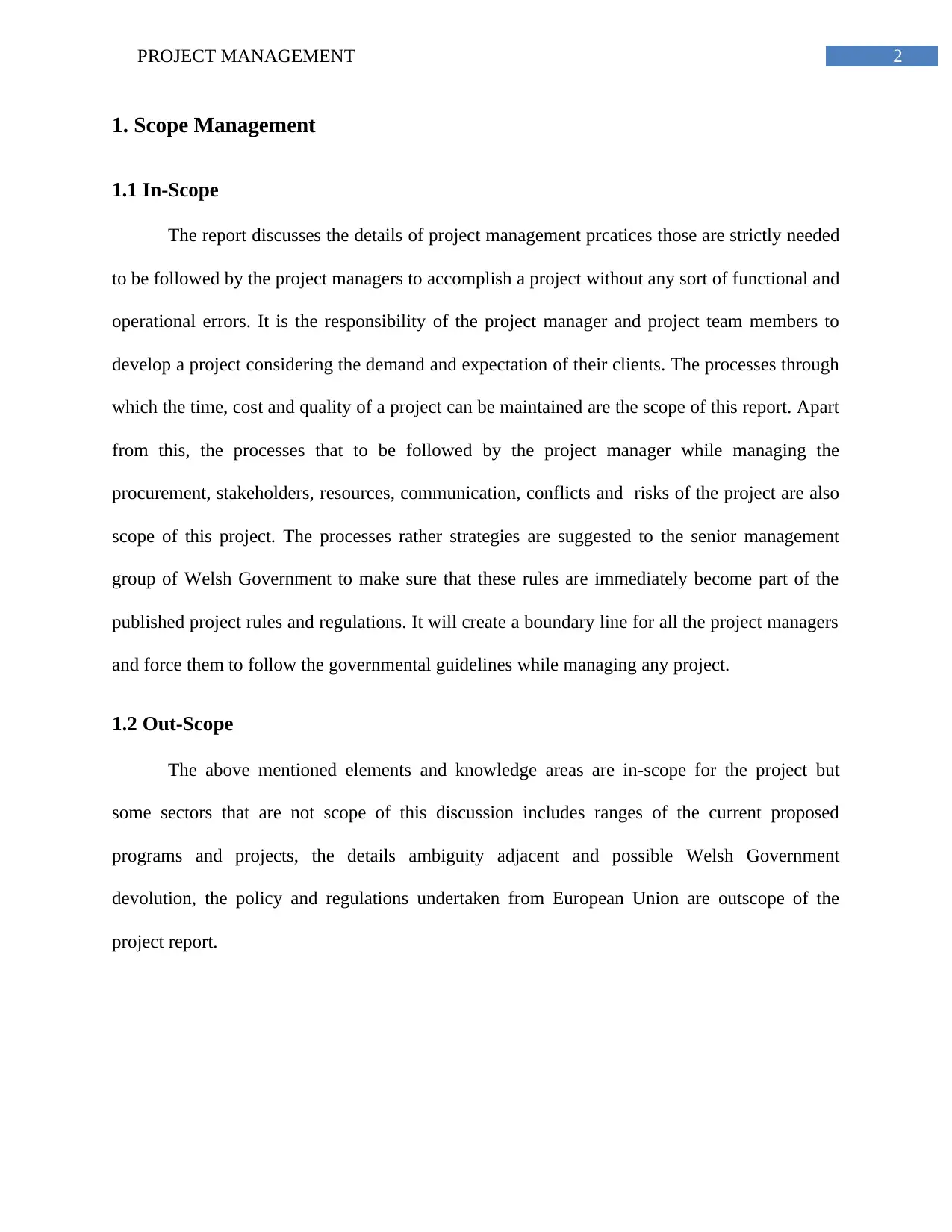
2PROJECT MANAGEMENT
1. Scope Management
1.1 In-Scope
The report discusses the details of project management prcatices those are strictly needed
to be followed by the project managers to accomplish a project without any sort of functional and
operational errors. It is the responsibility of the project manager and project team members to
develop a project considering the demand and expectation of their clients. The processes through
which the time, cost and quality of a project can be maintained are the scope of this report. Apart
from this, the processes that to be followed by the project manager while managing the
procurement, stakeholders, resources, communication, conflicts and risks of the project are also
scope of this project. The processes rather strategies are suggested to the senior management
group of Welsh Government to make sure that these rules are immediately become part of the
published project rules and regulations. It will create a boundary line for all the project managers
and force them to follow the governmental guidelines while managing any project.
1.2 Out-Scope
The above mentioned elements and knowledge areas are in-scope for the project but
some sectors that are not scope of this discussion includes ranges of the current proposed
programs and projects, the details ambiguity adjacent and possible Welsh Government
devolution, the policy and regulations undertaken from European Union are outscope of the
project report.
1. Scope Management
1.1 In-Scope
The report discusses the details of project management prcatices those are strictly needed
to be followed by the project managers to accomplish a project without any sort of functional and
operational errors. It is the responsibility of the project manager and project team members to
develop a project considering the demand and expectation of their clients. The processes through
which the time, cost and quality of a project can be maintained are the scope of this report. Apart
from this, the processes that to be followed by the project manager while managing the
procurement, stakeholders, resources, communication, conflicts and risks of the project are also
scope of this project. The processes rather strategies are suggested to the senior management
group of Welsh Government to make sure that these rules are immediately become part of the
published project rules and regulations. It will create a boundary line for all the project managers
and force them to follow the governmental guidelines while managing any project.
1.2 Out-Scope
The above mentioned elements and knowledge areas are in-scope for the project but
some sectors that are not scope of this discussion includes ranges of the current proposed
programs and projects, the details ambiguity adjacent and possible Welsh Government
devolution, the policy and regulations undertaken from European Union are outscope of the
project report.
⊘ This is a preview!⊘
Do you want full access?
Subscribe today to unlock all pages.

Trusted by 1+ million students worldwide
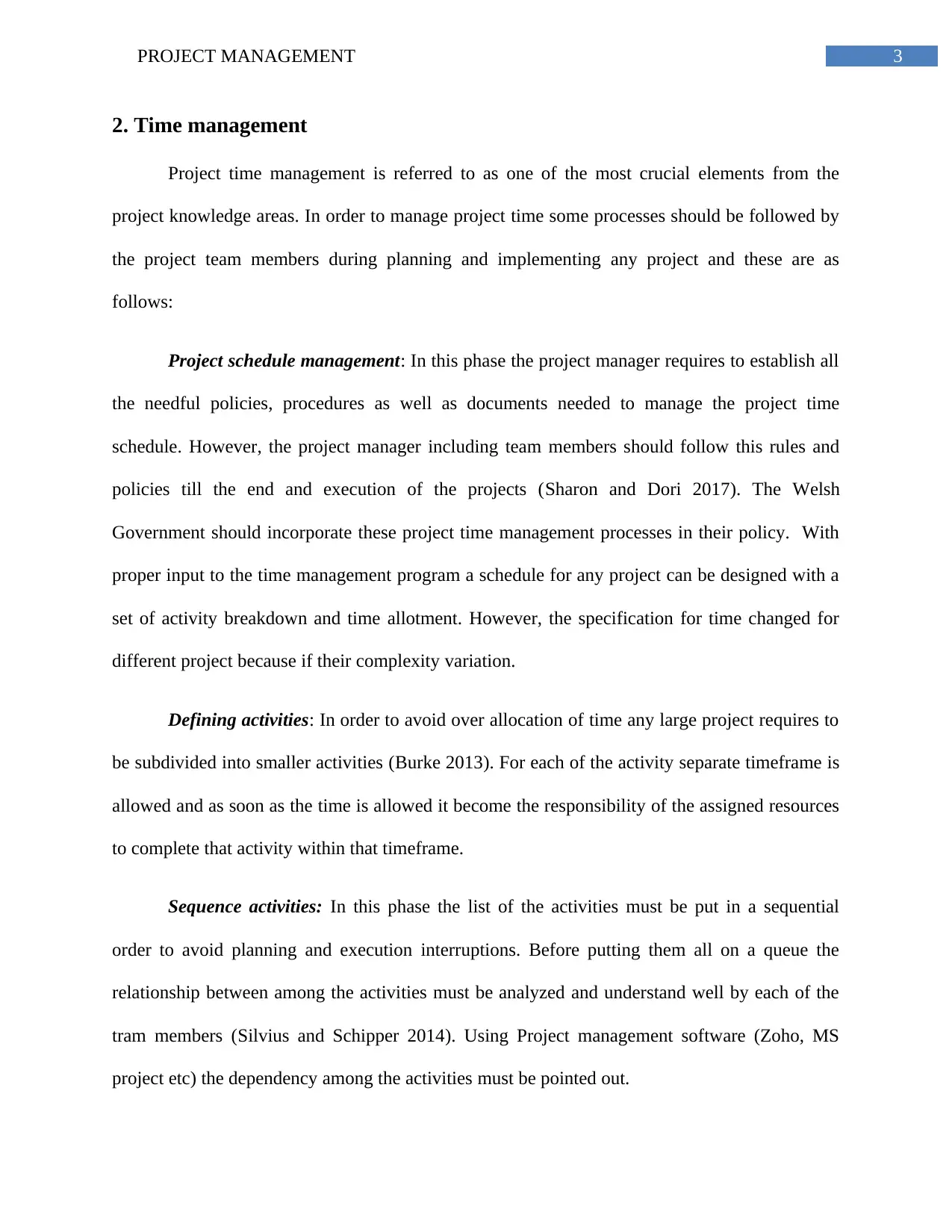
3PROJECT MANAGEMENT
2. Time management
Project time management is referred to as one of the most crucial elements from the
project knowledge areas. In order to manage project time some processes should be followed by
the project team members during planning and implementing any project and these are as
follows:
Project schedule management: In this phase the project manager requires to establish all
the needful policies, procedures as well as documents needed to manage the project time
schedule. However, the project manager including team members should follow this rules and
policies till the end and execution of the projects (Sharon and Dori 2017). The Welsh
Government should incorporate these project time management processes in their policy. With
proper input to the time management program a schedule for any project can be designed with a
set of activity breakdown and time allotment. However, the specification for time changed for
different project because if their complexity variation.
Defining activities: In order to avoid over allocation of time any large project requires to
be subdivided into smaller activities (Burke 2013). For each of the activity separate timeframe is
allowed and as soon as the time is allowed it become the responsibility of the assigned resources
to complete that activity within that timeframe.
Sequence activities: In this phase the list of the activities must be put in a sequential
order to avoid planning and execution interruptions. Before putting them all on a queue the
relationship between among the activities must be analyzed and understand well by each of the
tram members (Silvius and Schipper 2014). Using Project management software (Zoho, MS
project etc) the dependency among the activities must be pointed out.
2. Time management
Project time management is referred to as one of the most crucial elements from the
project knowledge areas. In order to manage project time some processes should be followed by
the project team members during planning and implementing any project and these are as
follows:
Project schedule management: In this phase the project manager requires to establish all
the needful policies, procedures as well as documents needed to manage the project time
schedule. However, the project manager including team members should follow this rules and
policies till the end and execution of the projects (Sharon and Dori 2017). The Welsh
Government should incorporate these project time management processes in their policy. With
proper input to the time management program a schedule for any project can be designed with a
set of activity breakdown and time allotment. However, the specification for time changed for
different project because if their complexity variation.
Defining activities: In order to avoid over allocation of time any large project requires to
be subdivided into smaller activities (Burke 2013). For each of the activity separate timeframe is
allowed and as soon as the time is allowed it become the responsibility of the assigned resources
to complete that activity within that timeframe.
Sequence activities: In this phase the list of the activities must be put in a sequential
order to avoid planning and execution interruptions. Before putting them all on a queue the
relationship between among the activities must be analyzed and understand well by each of the
tram members (Silvius and Schipper 2014). Using Project management software (Zoho, MS
project etc) the dependency among the activities must be pointed out.
Paraphrase This Document
Need a fresh take? Get an instant paraphrase of this document with our AI Paraphraser
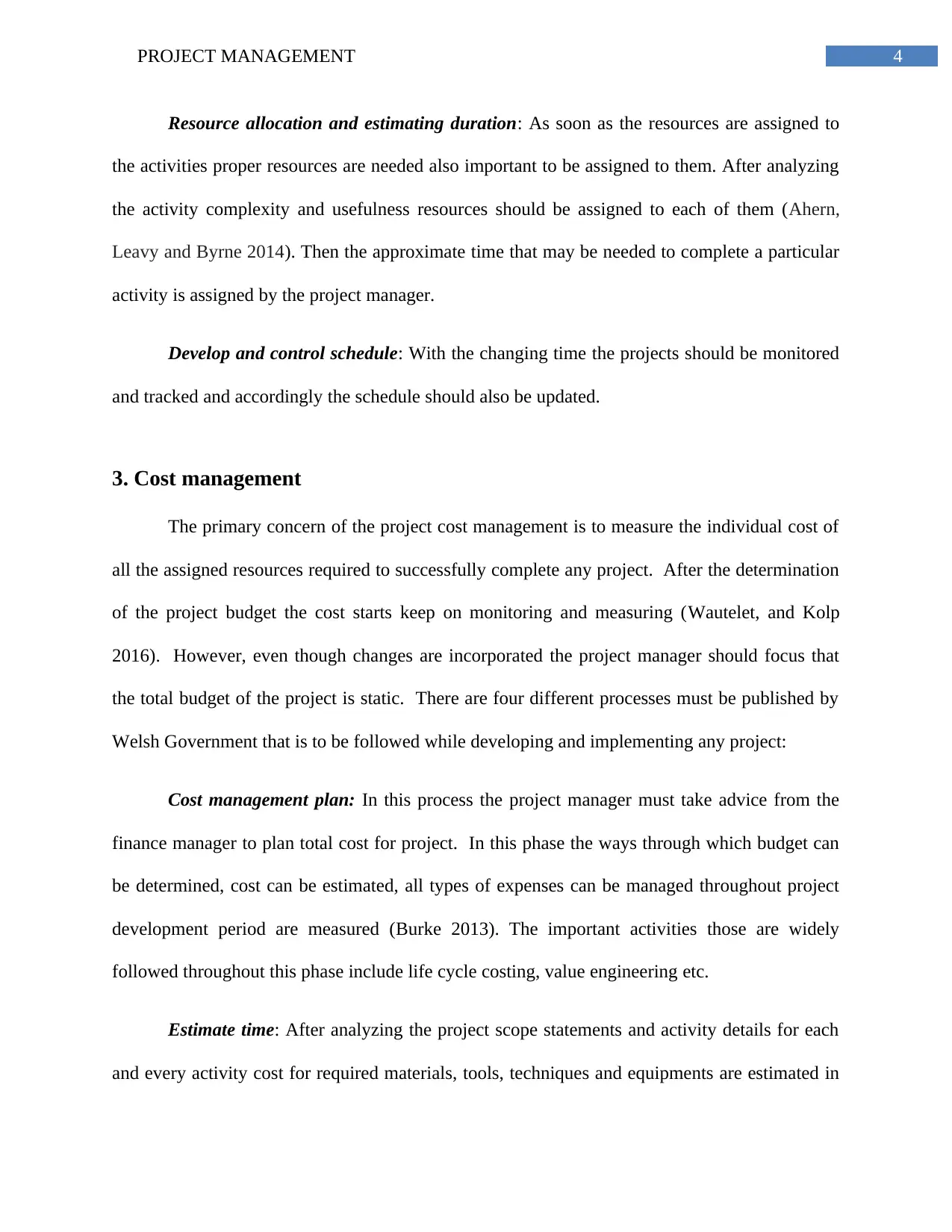
4PROJECT MANAGEMENT
Resource allocation and estimating duration: As soon as the resources are assigned to
the activities proper resources are needed also important to be assigned to them. After analyzing
the activity complexity and usefulness resources should be assigned to each of them (Ahern,
Leavy and Byrne 2014). Then the approximate time that may be needed to complete a particular
activity is assigned by the project manager.
Develop and control schedule: With the changing time the projects should be monitored
and tracked and accordingly the schedule should also be updated.
3. Cost management
The primary concern of the project cost management is to measure the individual cost of
all the assigned resources required to successfully complete any project. After the determination
of the project budget the cost starts keep on monitoring and measuring (Wautelet, and Kolp
2016). However, even though changes are incorporated the project manager should focus that
the total budget of the project is static. There are four different processes must be published by
Welsh Government that is to be followed while developing and implementing any project:
Cost management plan: In this process the project manager must take advice from the
finance manager to plan total cost for project. In this phase the ways through which budget can
be determined, cost can be estimated, all types of expenses can be managed throughout project
development period are measured (Burke 2013). The important activities those are widely
followed throughout this phase include life cycle costing, value engineering etc.
Estimate time: After analyzing the project scope statements and activity details for each
and every activity cost for required materials, tools, techniques and equipments are estimated in
Resource allocation and estimating duration: As soon as the resources are assigned to
the activities proper resources are needed also important to be assigned to them. After analyzing
the activity complexity and usefulness resources should be assigned to each of them (Ahern,
Leavy and Byrne 2014). Then the approximate time that may be needed to complete a particular
activity is assigned by the project manager.
Develop and control schedule: With the changing time the projects should be monitored
and tracked and accordingly the schedule should also be updated.
3. Cost management
The primary concern of the project cost management is to measure the individual cost of
all the assigned resources required to successfully complete any project. After the determination
of the project budget the cost starts keep on monitoring and measuring (Wautelet, and Kolp
2016). However, even though changes are incorporated the project manager should focus that
the total budget of the project is static. There are four different processes must be published by
Welsh Government that is to be followed while developing and implementing any project:
Cost management plan: In this process the project manager must take advice from the
finance manager to plan total cost for project. In this phase the ways through which budget can
be determined, cost can be estimated, all types of expenses can be managed throughout project
development period are measured (Burke 2013). The important activities those are widely
followed throughout this phase include life cycle costing, value engineering etc.
Estimate time: After analyzing the project scope statements and activity details for each
and every activity cost for required materials, tools, techniques and equipments are estimated in
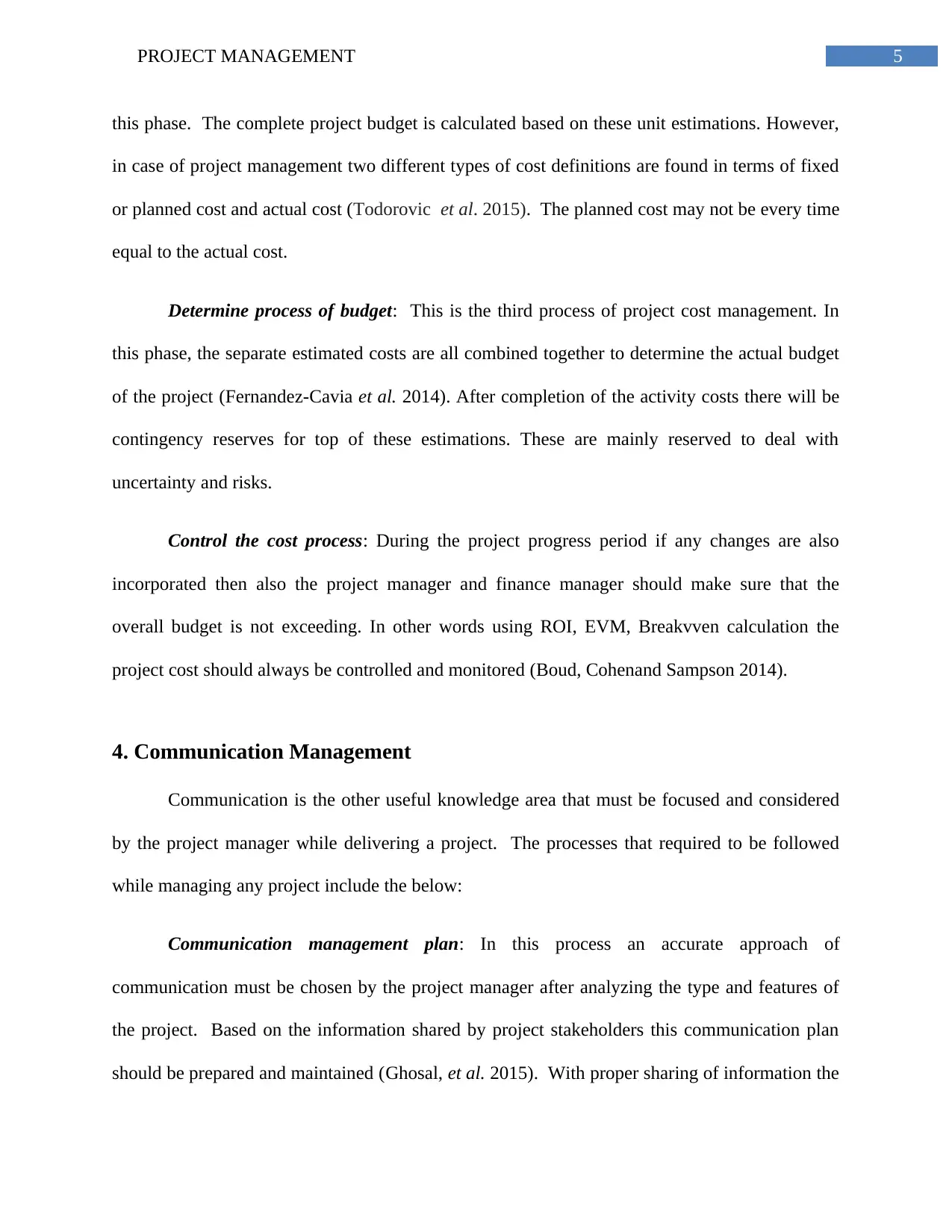
5PROJECT MANAGEMENT
this phase. The complete project budget is calculated based on these unit estimations. However,
in case of project management two different types of cost definitions are found in terms of fixed
or planned cost and actual cost (Todorovic et al. 2015). The planned cost may not be every time
equal to the actual cost.
Determine process of budget: This is the third process of project cost management. In
this phase, the separate estimated costs are all combined together to determine the actual budget
of the project (Fernandez-Cavia et al. 2014). After completion of the activity costs there will be
contingency reserves for top of these estimations. These are mainly reserved to deal with
uncertainty and risks.
Control the cost process: During the project progress period if any changes are also
incorporated then also the project manager and finance manager should make sure that the
overall budget is not exceeding. In other words using ROI, EVM, Breakvven calculation the
project cost should always be controlled and monitored (Boud, Cohenand Sampson 2014).
4. Communication Management
Communication is the other useful knowledge area that must be focused and considered
by the project manager while delivering a project. The processes that required to be followed
while managing any project include the below:
Communication management plan: In this process an accurate approach of
communication must be chosen by the project manager after analyzing the type and features of
the project. Based on the information shared by project stakeholders this communication plan
should be prepared and maintained (Ghosal, et al. 2015). With proper sharing of information the
this phase. The complete project budget is calculated based on these unit estimations. However,
in case of project management two different types of cost definitions are found in terms of fixed
or planned cost and actual cost (Todorovic et al. 2015). The planned cost may not be every time
equal to the actual cost.
Determine process of budget: This is the third process of project cost management. In
this phase, the separate estimated costs are all combined together to determine the actual budget
of the project (Fernandez-Cavia et al. 2014). After completion of the activity costs there will be
contingency reserves for top of these estimations. These are mainly reserved to deal with
uncertainty and risks.
Control the cost process: During the project progress period if any changes are also
incorporated then also the project manager and finance manager should make sure that the
overall budget is not exceeding. In other words using ROI, EVM, Breakvven calculation the
project cost should always be controlled and monitored (Boud, Cohenand Sampson 2014).
4. Communication Management
Communication is the other useful knowledge area that must be focused and considered
by the project manager while delivering a project. The processes that required to be followed
while managing any project include the below:
Communication management plan: In this process an accurate approach of
communication must be chosen by the project manager after analyzing the type and features of
the project. Based on the information shared by project stakeholders this communication plan
should be prepared and maintained (Ghosal, et al. 2015). With proper sharing of information the
⊘ This is a preview!⊘
Do you want full access?
Subscribe today to unlock all pages.

Trusted by 1+ million students worldwide
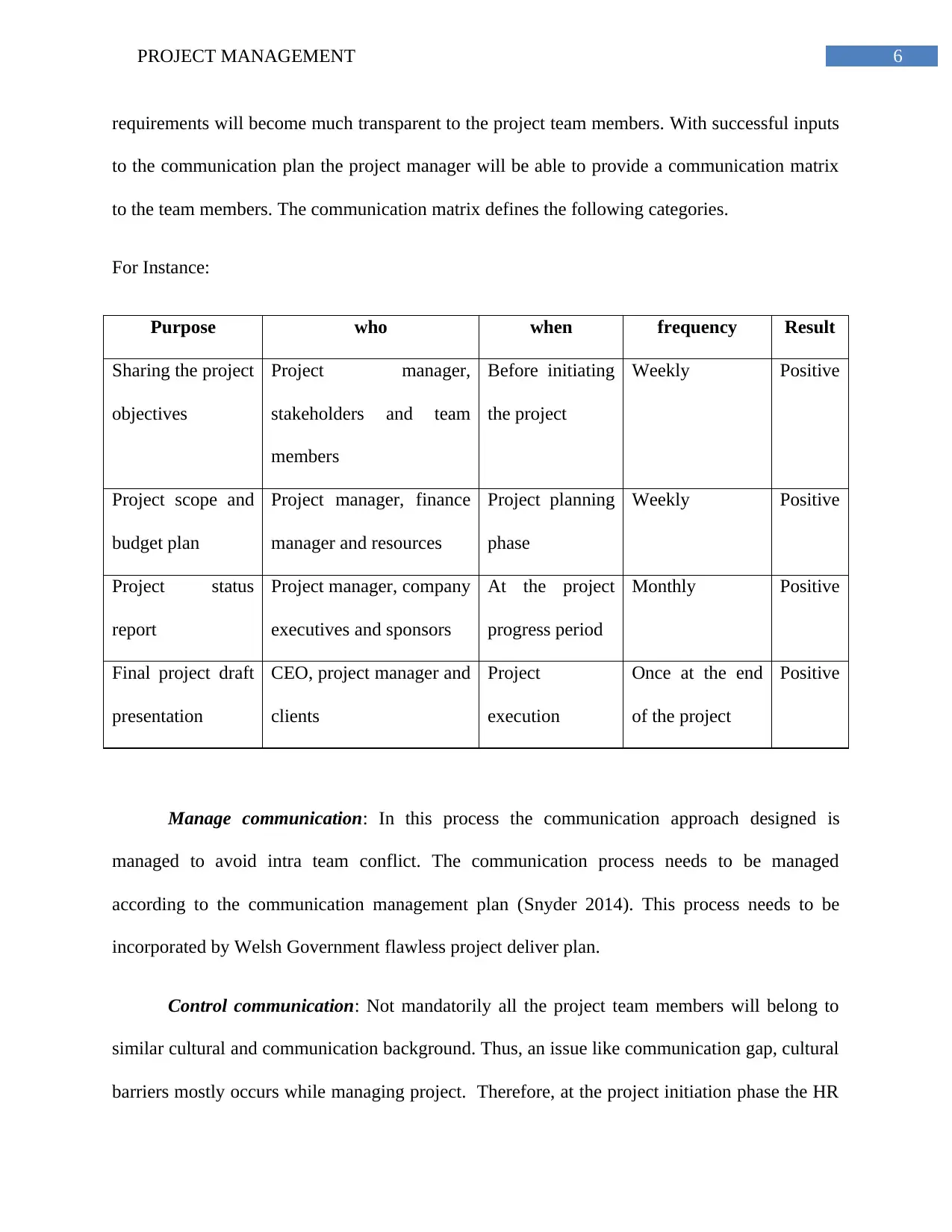
6PROJECT MANAGEMENT
requirements will become much transparent to the project team members. With successful inputs
to the communication plan the project manager will be able to provide a communication matrix
to the team members. The communication matrix defines the following categories.
For Instance:
Purpose who when frequency Result
Sharing the project
objectives
Project manager,
stakeholders and team
members
Before initiating
the project
Weekly Positive
Project scope and
budget plan
Project manager, finance
manager and resources
Project planning
phase
Weekly Positive
Project status
report
Project manager, company
executives and sponsors
At the project
progress period
Monthly Positive
Final project draft
presentation
CEO, project manager and
clients
Project
execution
Once at the end
of the project
Positive
Manage communication: In this process the communication approach designed is
managed to avoid intra team conflict. The communication process needs to be managed
according to the communication management plan (Snyder 2014). This process needs to be
incorporated by Welsh Government flawless project deliver plan.
Control communication: Not mandatorily all the project team members will belong to
similar cultural and communication background. Thus, an issue like communication gap, cultural
barriers mostly occurs while managing project. Therefore, at the project initiation phase the HR
requirements will become much transparent to the project team members. With successful inputs
to the communication plan the project manager will be able to provide a communication matrix
to the team members. The communication matrix defines the following categories.
For Instance:
Purpose who when frequency Result
Sharing the project
objectives
Project manager,
stakeholders and team
members
Before initiating
the project
Weekly Positive
Project scope and
budget plan
Project manager, finance
manager and resources
Project planning
phase
Weekly Positive
Project status
report
Project manager, company
executives and sponsors
At the project
progress period
Monthly Positive
Final project draft
presentation
CEO, project manager and
clients
Project
execution
Once at the end
of the project
Positive
Manage communication: In this process the communication approach designed is
managed to avoid intra team conflict. The communication process needs to be managed
according to the communication management plan (Snyder 2014). This process needs to be
incorporated by Welsh Government flawless project deliver plan.
Control communication: Not mandatorily all the project team members will belong to
similar cultural and communication background. Thus, an issue like communication gap, cultural
barriers mostly occurs while managing project. Therefore, at the project initiation phase the HR
Paraphrase This Document
Need a fresh take? Get an instant paraphrase of this document with our AI Paraphraser
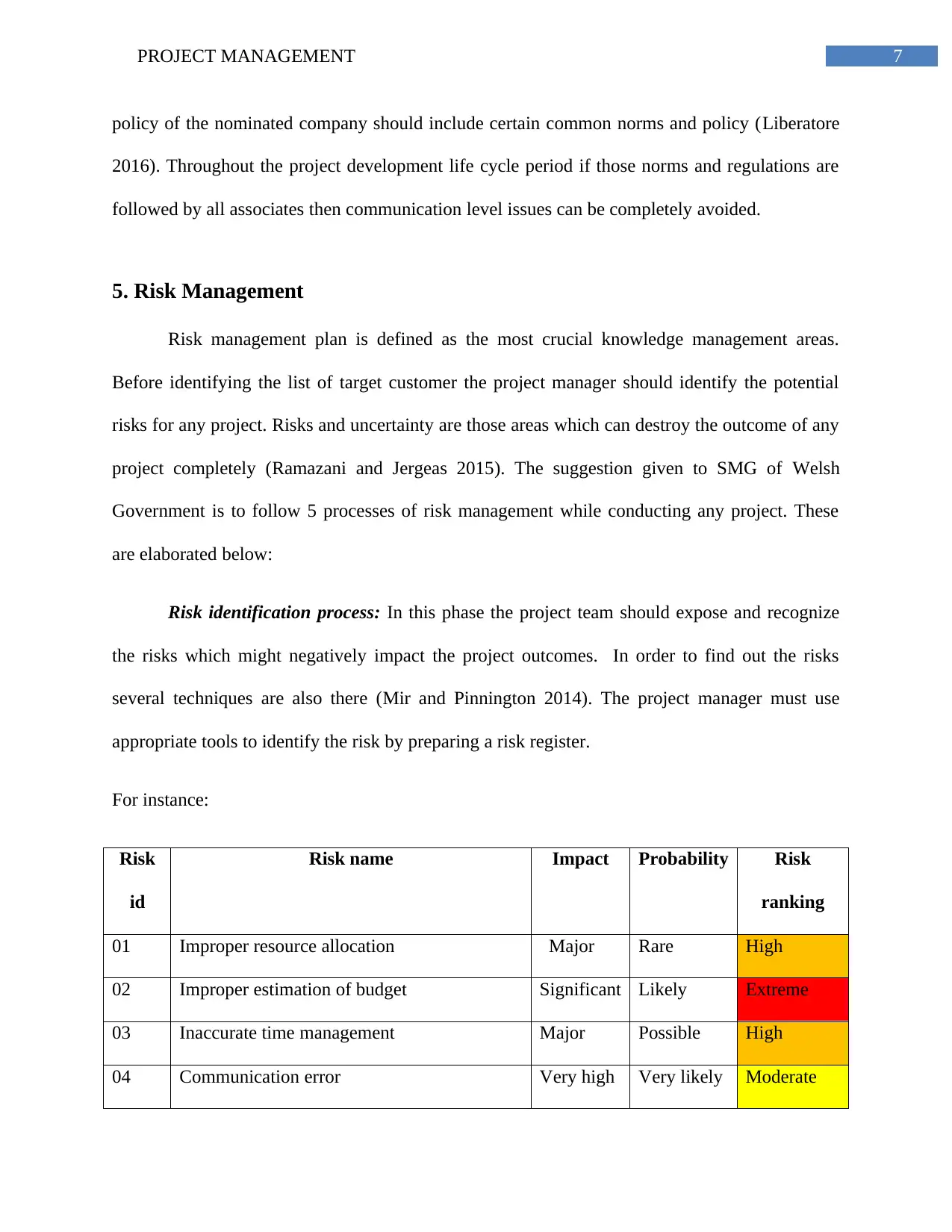
7PROJECT MANAGEMENT
policy of the nominated company should include certain common norms and policy (Liberatore
2016). Throughout the project development life cycle period if those norms and regulations are
followed by all associates then communication level issues can be completely avoided.
5. Risk Management
Risk management plan is defined as the most crucial knowledge management areas.
Before identifying the list of target customer the project manager should identify the potential
risks for any project. Risks and uncertainty are those areas which can destroy the outcome of any
project completely (Ramazani and Jergeas 2015). The suggestion given to SMG of Welsh
Government is to follow 5 processes of risk management while conducting any project. These
are elaborated below:
Risk identification process: In this phase the project team should expose and recognize
the risks which might negatively impact the project outcomes. In order to find out the risks
several techniques are also there (Mir and Pinnington 2014). The project manager must use
appropriate tools to identify the risk by preparing a risk register.
For instance:
Risk
id
Risk name Impact Probability Risk
ranking
01 Improper resource allocation Major Rare High
02 Improper estimation of budget Significant Likely Extreme
03 Inaccurate time management Major Possible High
04 Communication error Very high Very likely Moderate
policy of the nominated company should include certain common norms and policy (Liberatore
2016). Throughout the project development life cycle period if those norms and regulations are
followed by all associates then communication level issues can be completely avoided.
5. Risk Management
Risk management plan is defined as the most crucial knowledge management areas.
Before identifying the list of target customer the project manager should identify the potential
risks for any project. Risks and uncertainty are those areas which can destroy the outcome of any
project completely (Ramazani and Jergeas 2015). The suggestion given to SMG of Welsh
Government is to follow 5 processes of risk management while conducting any project. These
are elaborated below:
Risk identification process: In this phase the project team should expose and recognize
the risks which might negatively impact the project outcomes. In order to find out the risks
several techniques are also there (Mir and Pinnington 2014). The project manager must use
appropriate tools to identify the risk by preparing a risk register.
For instance:
Risk
id
Risk name Impact Probability Risk
ranking
01 Improper resource allocation Major Rare High
02 Improper estimation of budget Significant Likely Extreme
03 Inaccurate time management Major Possible High
04 Communication error Very high Very likely Moderate
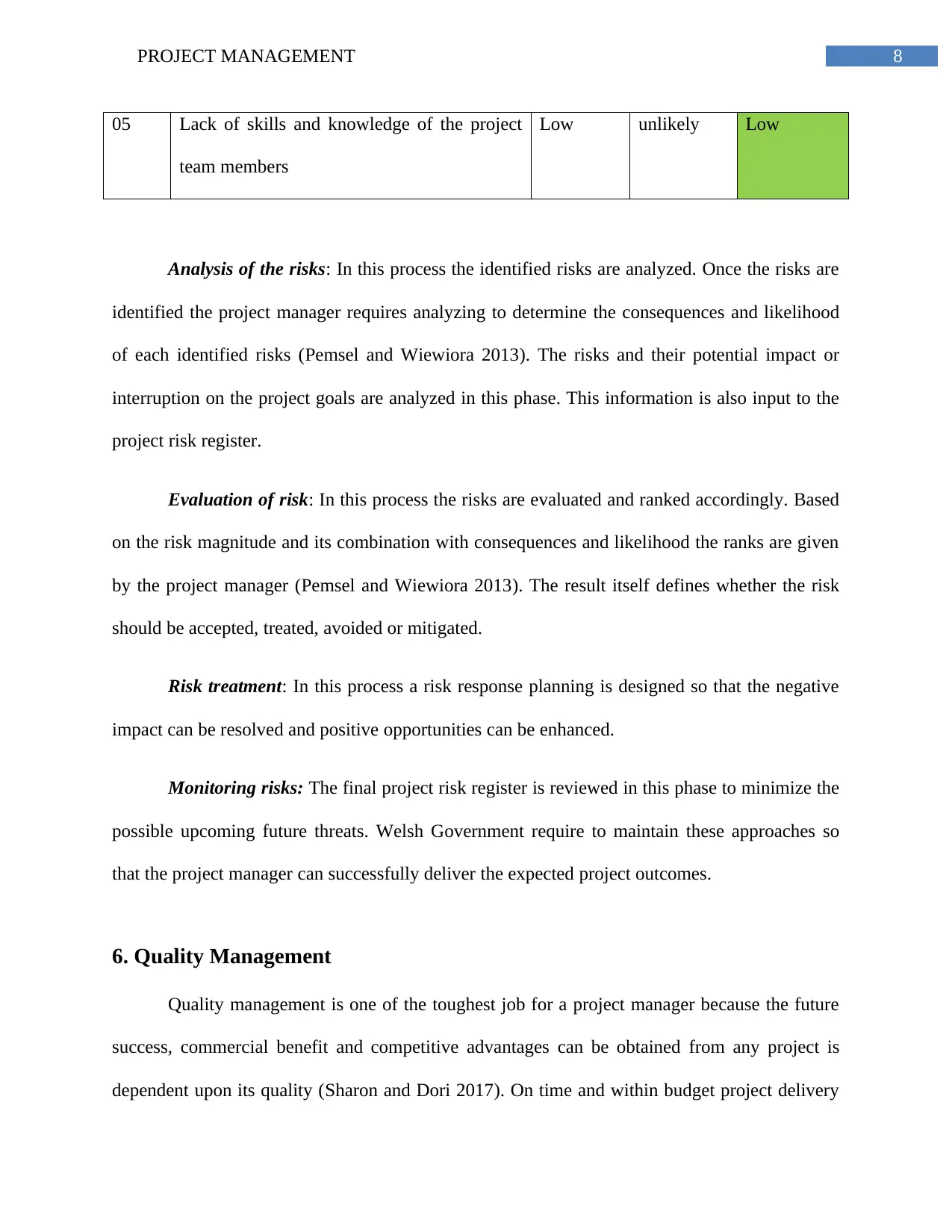
8PROJECT MANAGEMENT
05 Lack of skills and knowledge of the project
team members
Low unlikely Low
Analysis of the risks: In this process the identified risks are analyzed. Once the risks are
identified the project manager requires analyzing to determine the consequences and likelihood
of each identified risks (Pemsel and Wiewiora 2013). The risks and their potential impact or
interruption on the project goals are analyzed in this phase. This information is also input to the
project risk register.
Evaluation of risk: In this process the risks are evaluated and ranked accordingly. Based
on the risk magnitude and its combination with consequences and likelihood the ranks are given
by the project manager (Pemsel and Wiewiora 2013). The result itself defines whether the risk
should be accepted, treated, avoided or mitigated.
Risk treatment: In this process a risk response planning is designed so that the negative
impact can be resolved and positive opportunities can be enhanced.
Monitoring risks: The final project risk register is reviewed in this phase to minimize the
possible upcoming future threats. Welsh Government require to maintain these approaches so
that the project manager can successfully deliver the expected project outcomes.
6. Quality Management
Quality management is one of the toughest job for a project manager because the future
success, commercial benefit and competitive advantages can be obtained from any project is
dependent upon its quality (Sharon and Dori 2017). On time and within budget project delivery
05 Lack of skills and knowledge of the project
team members
Low unlikely Low
Analysis of the risks: In this process the identified risks are analyzed. Once the risks are
identified the project manager requires analyzing to determine the consequences and likelihood
of each identified risks (Pemsel and Wiewiora 2013). The risks and their potential impact or
interruption on the project goals are analyzed in this phase. This information is also input to the
project risk register.
Evaluation of risk: In this process the risks are evaluated and ranked accordingly. Based
on the risk magnitude and its combination with consequences and likelihood the ranks are given
by the project manager (Pemsel and Wiewiora 2013). The result itself defines whether the risk
should be accepted, treated, avoided or mitigated.
Risk treatment: In this process a risk response planning is designed so that the negative
impact can be resolved and positive opportunities can be enhanced.
Monitoring risks: The final project risk register is reviewed in this phase to minimize the
possible upcoming future threats. Welsh Government require to maintain these approaches so
that the project manager can successfully deliver the expected project outcomes.
6. Quality Management
Quality management is one of the toughest job for a project manager because the future
success, commercial benefit and competitive advantages can be obtained from any project is
dependent upon its quality (Sharon and Dori 2017). On time and within budget project delivery
⊘ This is a preview!⊘
Do you want full access?
Subscribe today to unlock all pages.

Trusted by 1+ million students worldwide
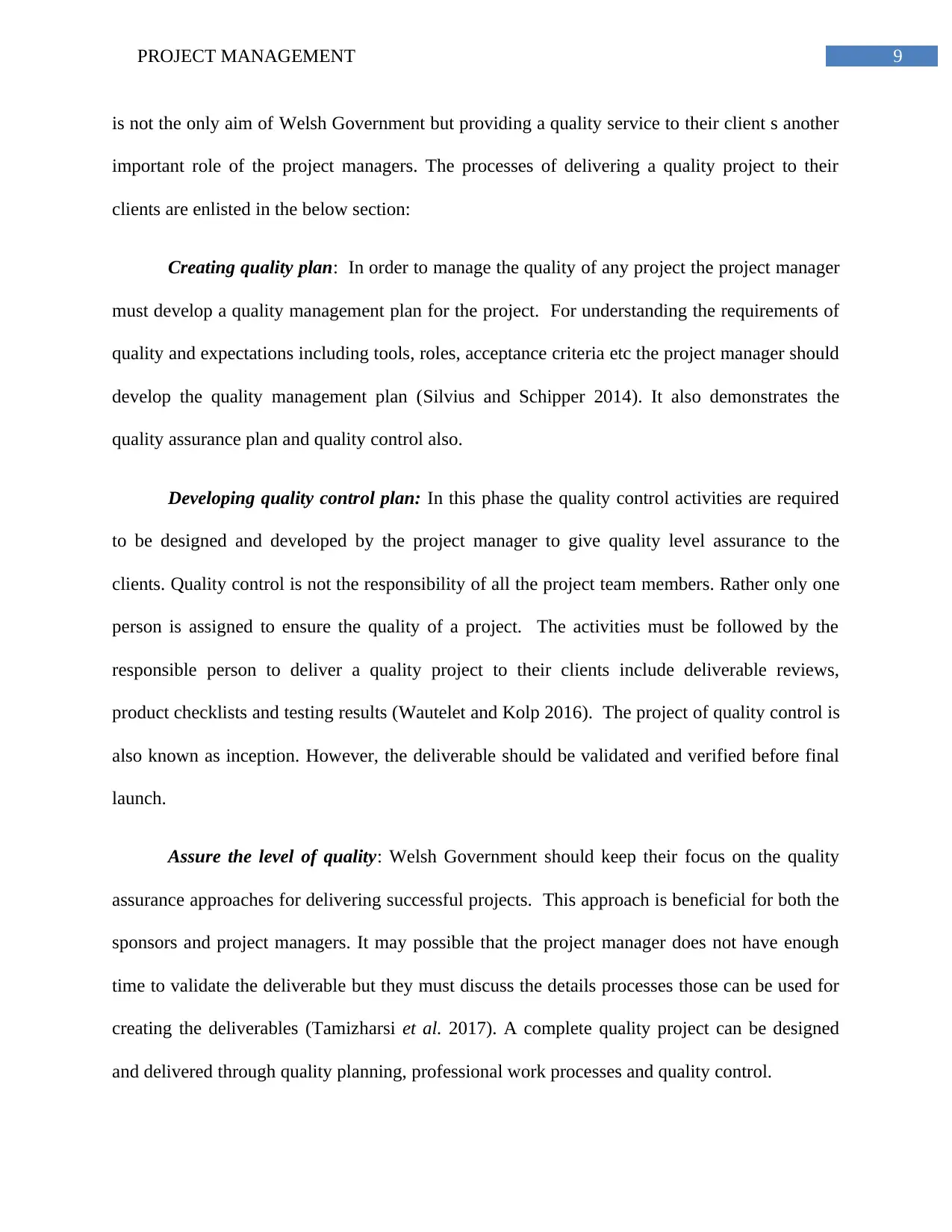
9PROJECT MANAGEMENT
is not the only aim of Welsh Government but providing a quality service to their client s another
important role of the project managers. The processes of delivering a quality project to their
clients are enlisted in the below section:
Creating quality plan: In order to manage the quality of any project the project manager
must develop a quality management plan for the project. For understanding the requirements of
quality and expectations including tools, roles, acceptance criteria etc the project manager should
develop the quality management plan (Silvius and Schipper 2014). It also demonstrates the
quality assurance plan and quality control also.
Developing quality control plan: In this phase the quality control activities are required
to be designed and developed by the project manager to give quality level assurance to the
clients. Quality control is not the responsibility of all the project team members. Rather only one
person is assigned to ensure the quality of a project. The activities must be followed by the
responsible person to deliver a quality project to their clients include deliverable reviews,
product checklists and testing results (Wautelet and Kolp 2016). The project of quality control is
also known as inception. However, the deliverable should be validated and verified before final
launch.
Assure the level of quality: Welsh Government should keep their focus on the quality
assurance approaches for delivering successful projects. This approach is beneficial for both the
sponsors and project managers. It may possible that the project manager does not have enough
time to validate the deliverable but they must discuss the details processes those can be used for
creating the deliverables (Tamizharsi et al. 2017). A complete quality project can be designed
and delivered through quality planning, professional work processes and quality control.
is not the only aim of Welsh Government but providing a quality service to their client s another
important role of the project managers. The processes of delivering a quality project to their
clients are enlisted in the below section:
Creating quality plan: In order to manage the quality of any project the project manager
must develop a quality management plan for the project. For understanding the requirements of
quality and expectations including tools, roles, acceptance criteria etc the project manager should
develop the quality management plan (Silvius and Schipper 2014). It also demonstrates the
quality assurance plan and quality control also.
Developing quality control plan: In this phase the quality control activities are required
to be designed and developed by the project manager to give quality level assurance to the
clients. Quality control is not the responsibility of all the project team members. Rather only one
person is assigned to ensure the quality of a project. The activities must be followed by the
responsible person to deliver a quality project to their clients include deliverable reviews,
product checklists and testing results (Wautelet and Kolp 2016). The project of quality control is
also known as inception. However, the deliverable should be validated and verified before final
launch.
Assure the level of quality: Welsh Government should keep their focus on the quality
assurance approaches for delivering successful projects. This approach is beneficial for both the
sponsors and project managers. It may possible that the project manager does not have enough
time to validate the deliverable but they must discuss the details processes those can be used for
creating the deliverables (Tamizharsi et al. 2017). A complete quality project can be designed
and delivered through quality planning, professional work processes and quality control.
Paraphrase This Document
Need a fresh take? Get an instant paraphrase of this document with our AI Paraphraser
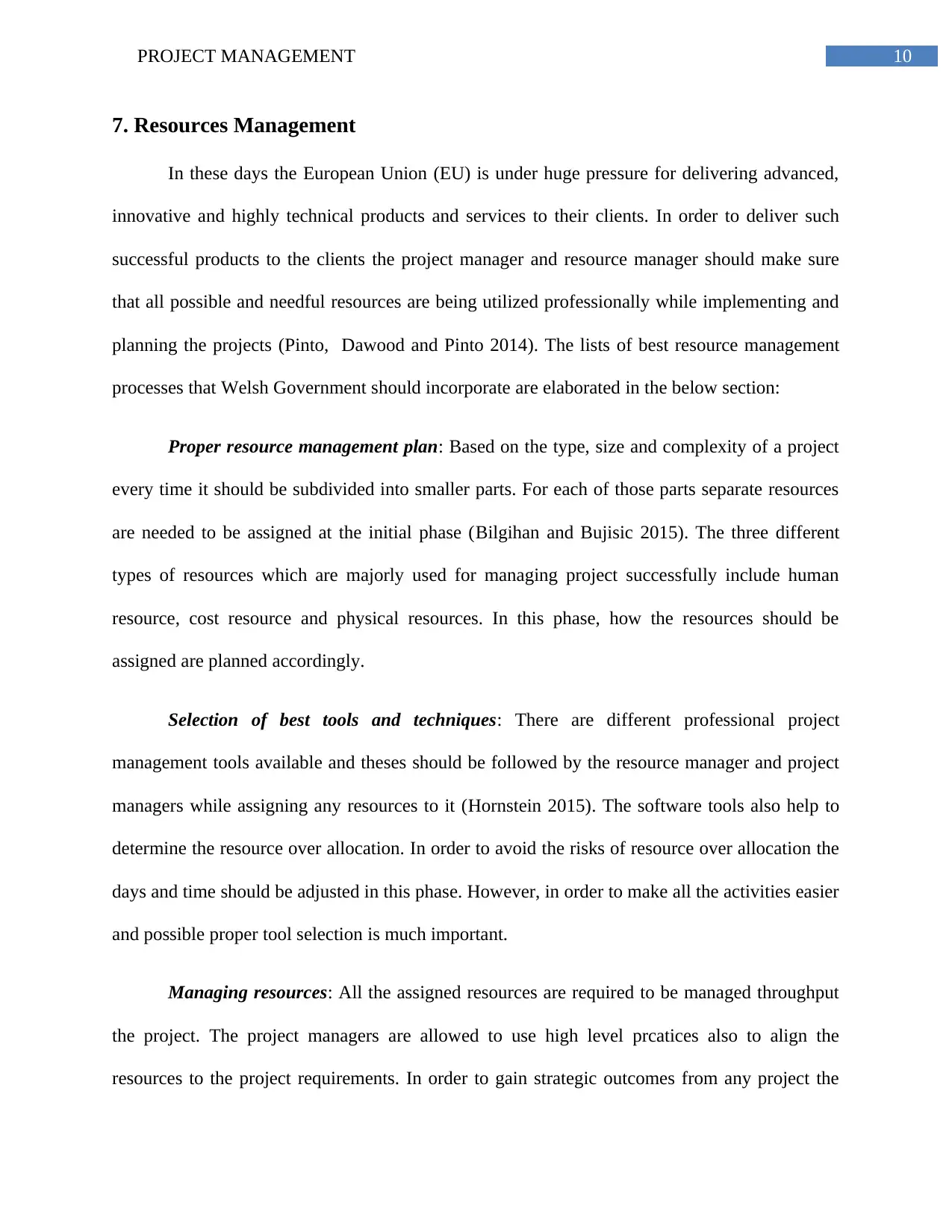
10PROJECT MANAGEMENT
7. Resources Management
In these days the European Union (EU) is under huge pressure for delivering advanced,
innovative and highly technical products and services to their clients. In order to deliver such
successful products to the clients the project manager and resource manager should make sure
that all possible and needful resources are being utilized professionally while implementing and
planning the projects (Pinto, Dawood and Pinto 2014). The lists of best resource management
processes that Welsh Government should incorporate are elaborated in the below section:
Proper resource management plan: Based on the type, size and complexity of a project
every time it should be subdivided into smaller parts. For each of those parts separate resources
are needed to be assigned at the initial phase (Bilgihan and Bujisic 2015). The three different
types of resources which are majorly used for managing project successfully include human
resource, cost resource and physical resources. In this phase, how the resources should be
assigned are planned accordingly.
Selection of best tools and techniques: There are different professional project
management tools available and theses should be followed by the resource manager and project
managers while assigning any resources to it (Hornstein 2015). The software tools also help to
determine the resource over allocation. In order to avoid the risks of resource over allocation the
days and time should be adjusted in this phase. However, in order to make all the activities easier
and possible proper tool selection is much important.
Managing resources: All the assigned resources are required to be managed throughput
the project. The project managers are allowed to use high level prcatices also to align the
resources to the project requirements. In order to gain strategic outcomes from any project the
7. Resources Management
In these days the European Union (EU) is under huge pressure for delivering advanced,
innovative and highly technical products and services to their clients. In order to deliver such
successful products to the clients the project manager and resource manager should make sure
that all possible and needful resources are being utilized professionally while implementing and
planning the projects (Pinto, Dawood and Pinto 2014). The lists of best resource management
processes that Welsh Government should incorporate are elaborated in the below section:
Proper resource management plan: Based on the type, size and complexity of a project
every time it should be subdivided into smaller parts. For each of those parts separate resources
are needed to be assigned at the initial phase (Bilgihan and Bujisic 2015). The three different
types of resources which are majorly used for managing project successfully include human
resource, cost resource and physical resources. In this phase, how the resources should be
assigned are planned accordingly.
Selection of best tools and techniques: There are different professional project
management tools available and theses should be followed by the resource manager and project
managers while assigning any resources to it (Hornstein 2015). The software tools also help to
determine the resource over allocation. In order to avoid the risks of resource over allocation the
days and time should be adjusted in this phase. However, in order to make all the activities easier
and possible proper tool selection is much important.
Managing resources: All the assigned resources are required to be managed throughput
the project. The project managers are allowed to use high level prcatices also to align the
resources to the project requirements. In order to gain strategic outcomes from any project the
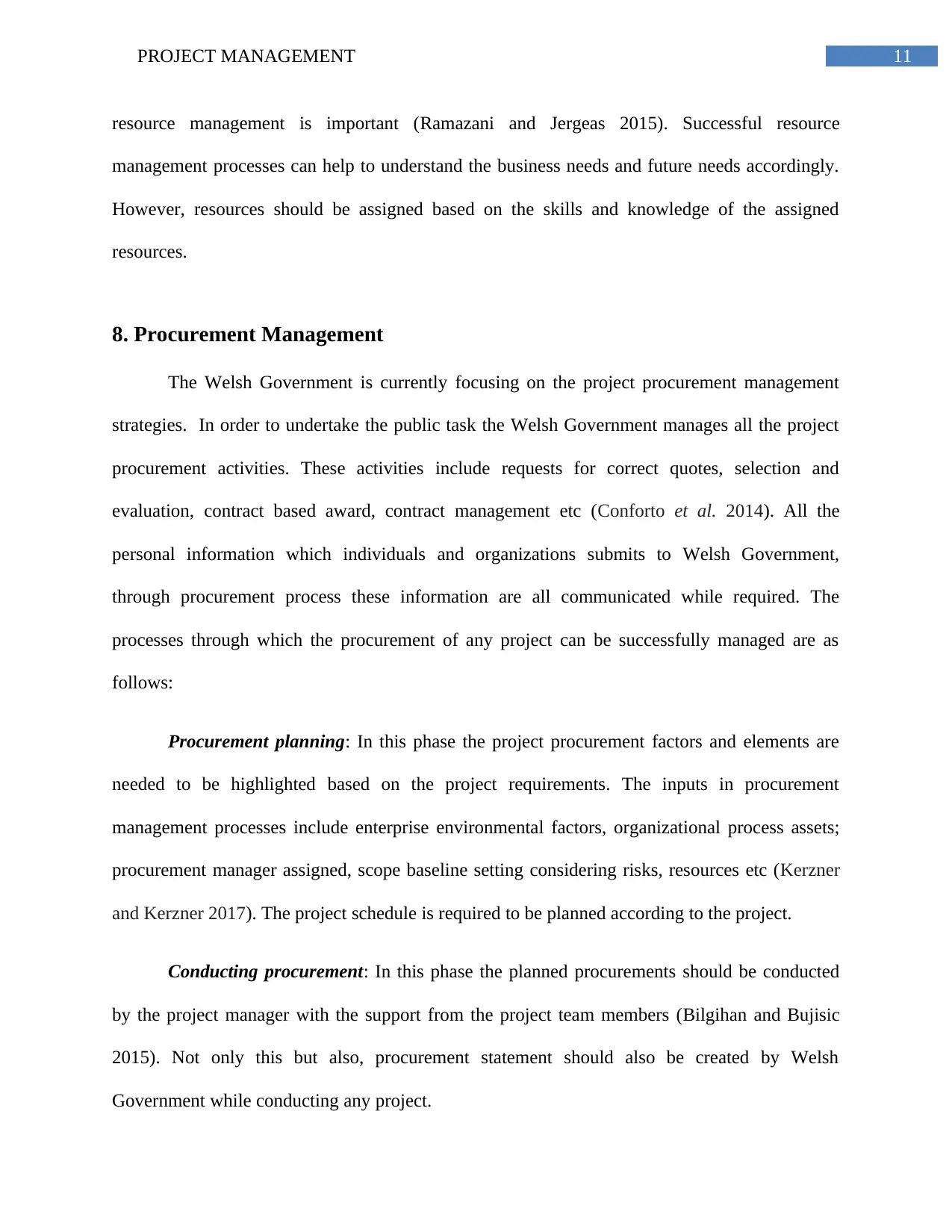
11PROJECT MANAGEMENT
resource management is important (Ramazani and Jergeas 2015). Successful resource
management processes can help to understand the business needs and future needs accordingly.
However, resources should be assigned based on the skills and knowledge of the assigned
resources.
8. Procurement Management
The Welsh Government is currently focusing on the project procurement management
strategies. In order to undertake the public task the Welsh Government manages all the project
procurement activities. These activities include requests for correct quotes, selection and
evaluation, contract based award, contract management etc (Conforto et al. 2014). All the
personal information which individuals and organizations submits to Welsh Government,
through procurement process these information are all communicated while required. The
processes through which the procurement of any project can be successfully managed are as
follows:
Procurement planning: In this phase the project procurement factors and elements are
needed to be highlighted based on the project requirements. The inputs in procurement
management processes include enterprise environmental factors, organizational process assets;
procurement manager assigned, scope baseline setting considering risks, resources etc (Kerzner
and Kerzner 2017). The project schedule is required to be planned according to the project.
Conducting procurement: In this phase the planned procurements should be conducted
by the project manager with the support from the project team members (Bilgihan and Bujisic
2015). Not only this but also, procurement statement should also be created by Welsh
Government while conducting any project.
resource management is important (Ramazani and Jergeas 2015). Successful resource
management processes can help to understand the business needs and future needs accordingly.
However, resources should be assigned based on the skills and knowledge of the assigned
resources.
8. Procurement Management
The Welsh Government is currently focusing on the project procurement management
strategies. In order to undertake the public task the Welsh Government manages all the project
procurement activities. These activities include requests for correct quotes, selection and
evaluation, contract based award, contract management etc (Conforto et al. 2014). All the
personal information which individuals and organizations submits to Welsh Government,
through procurement process these information are all communicated while required. The
processes through which the procurement of any project can be successfully managed are as
follows:
Procurement planning: In this phase the project procurement factors and elements are
needed to be highlighted based on the project requirements. The inputs in procurement
management processes include enterprise environmental factors, organizational process assets;
procurement manager assigned, scope baseline setting considering risks, resources etc (Kerzner
and Kerzner 2017). The project schedule is required to be planned according to the project.
Conducting procurement: In this phase the planned procurements should be conducted
by the project manager with the support from the project team members (Bilgihan and Bujisic
2015). Not only this but also, procurement statement should also be created by Welsh
Government while conducting any project.
⊘ This is a preview!⊘
Do you want full access?
Subscribe today to unlock all pages.

Trusted by 1+ million students worldwide
1 out of 23
Related Documents
Your All-in-One AI-Powered Toolkit for Academic Success.
+13062052269
info@desklib.com
Available 24*7 on WhatsApp / Email
![[object Object]](/_next/static/media/star-bottom.7253800d.svg)
Unlock your academic potential
Copyright © 2020–2025 A2Z Services. All Rights Reserved. Developed and managed by ZUCOL.





